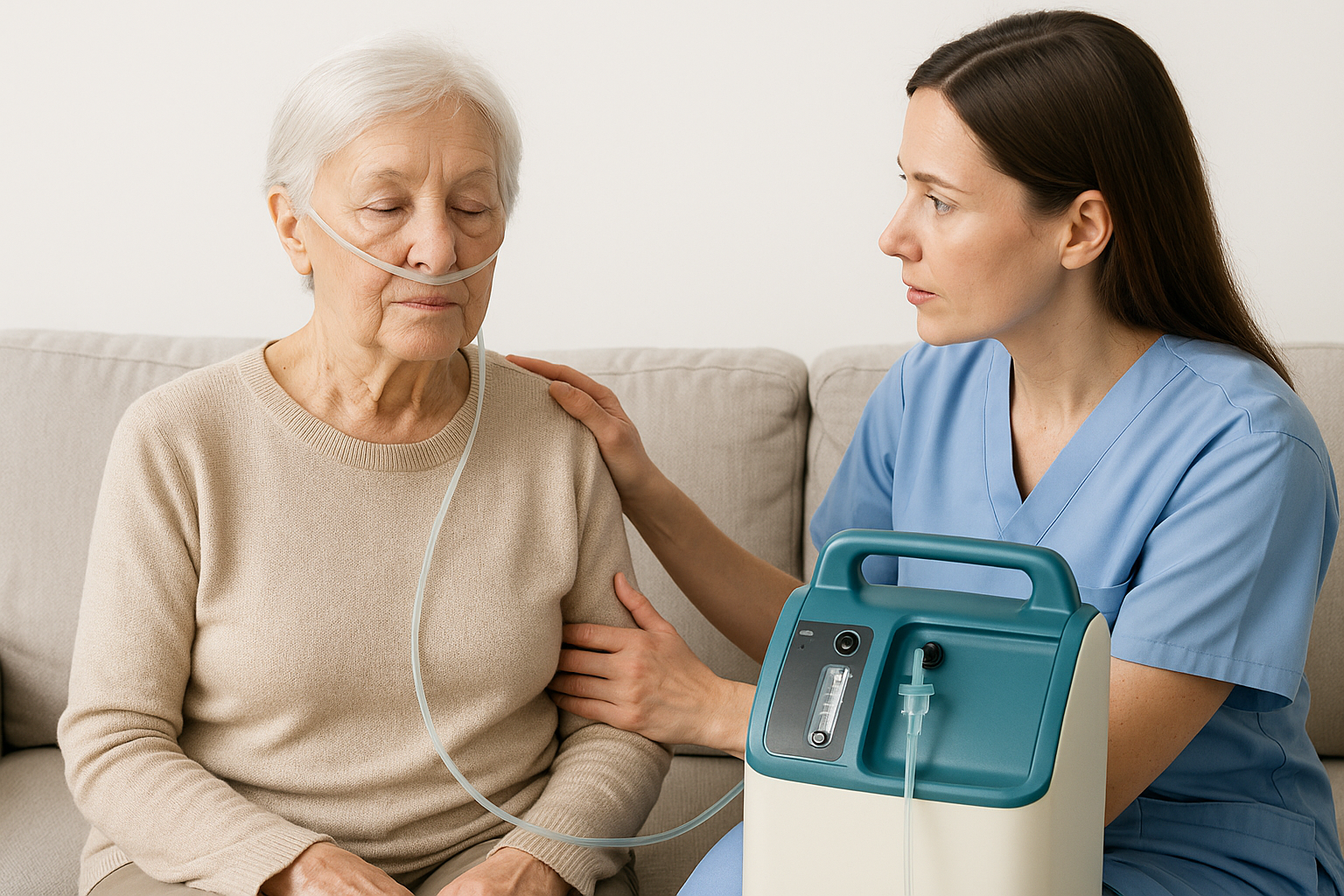Oxygen Therapy Services
Understanding Oxygen Therapy
Oxygen therapy plays a crucial role in supporting individuals with respiratory or cardiovascular conditions that limit the body’s ability to maintain healthy oxygen levels. By delivering supplemental oxygen, it helps improve breathing efficiency, reduce fatigue, support heart function, and enhance daily living.
At VeroHealth, we provide end-to-end oxygen therapy solutions tailored to your lifestyle and medical needs. From powerful home concentrators to sleek, travel-ready portable units, our certified specialists handle everything-from setup and insurance coordination to training and long-term support-ensuring safe, effective therapy you can count on.

Conditions Requiring Oxygen Therapy
COPD (Chronic Obstructive Pulmonary Disease)
Improves breathing and daily function with long-term oxygen support.
Pulmonary Hypertension
Reduces heart strain and enhances exercise tolerance.
Pulmonary Fibrosis
Maintains healthy oxygen levels as lung function declines.
Sleep-Related Breathing Disorders
Used for nocturnal hypoxemia or complex sleep apnea support.
Oxygen Equipment Options
VeroHealth offers a range of oxygen devices tailored to fit every patient’s lifestyle-whether at home, on the move, or requiring high-flow support.
Designed for 24/7 home use, these units provide consistent oxygen delivery with quiet, low-maintenance operation.
- High output (5–10 LPM)
- Operates continuously
- Quiet for home use
- Built-in safety alarms
- Easy to maintain
Compact and lightweight, these units offer freedom of mobility while maintaining reliable oxygen delivery anywhere.
- Travel-friendly design
- Battery powered options
- Continuous & pulse flow
- Airline approved
- Dual charging methods
Traditional oxygen delivery using refillable tanks; ideal for backup use or during power outages when concentrators may not function.
- Available in multiple sizes
- Provides high flow rates
- Ready-to-use backup
- Works without electricity
- Immediate supply access
Efficient cryogenic systems offering high-capacity oxygen in compact containers, suited for patients with extensive needs.
- Compact high capacity
- Quiet and efficient
- No electricity required
- Portable for mobility
- High flow compatible
Oxygen Delivery Methods
Delivers a steady stream of oxygen regardless of your breathing pattern. Best for patients needing consistent oxygen, especially during sleep or higher flow demands.
Features:- Constant oxygen delivery
- Supports all breathing patterns
- Higher flow rate capability
- Ideal for nighttime use
Oxygen is delivered only during inhalation, making this method efficient and ideal for conserving oxygen supply and battery life in portable units during daily activities.
Features:- Inhalation-triggered delivery
- Conserves oxygen & battery
- Lightweight and portable
- Best for mobile patients
Oxygen Therapy Eligibility
Medical Criteria for Oxygen Therapy
Oxygen therapy eligibility is determined through a thorough medical evaluation, including arterial blood gas analysis, pulse oximetry, and clinical assessment. Medicare and most insurance providers follow strict guidelines for coverage approval.
Resting Oxygen Levels
PaO2 ≤ 55 mmHg or SpO2 ≤ 88% at rest qualifies a patient for oxygen therapy coverage.
Exercise Oxygen Levels
SpO2 ≤ 88% during physical exertion, with documented improvement using oxygen.
Sleep-Related Hypoxemia
SpO2 ≤ 88% for at least 5 minutes during sleep, typically confirmed with a sleep study.
Qualifying Conditions
Diagnoses like COPD, pulmonary fibrosis, or pulmonary hypertension with evidence of hypoxemia.
Comprehensive Patient Support
In-Home Setup & Training
Professional delivery and setup of oxygen equipment with thorough training on safe operation, cleaning, and troubleshooting.
Safety Education
Detailed safety training on fire prevention, oxygen storage, and emergency procedures to ensure home safety.
24/7 Emergency Support
Immediate support for urgent oxygen equipment issues, including replacement and critical response services.
Delivery & Refill Services
Timely delivery of oxygen tanks, concentrators, and refills to maintain uninterrupted therapy.
Equipment Maintenance
Ongoing equipment inspections, filter replacements, and performance checks to ensure safe use.
Travel Support
Travel coordination with airlines, portable oxygen delivery, and destination assistance for mobile patients.
Getting Started with Oxygen Therapy
Medical Evaluation
Your physician will conduct tests like arterial blood gas analysis or pulse oximetry to determine eligibility for oxygen therapy.
Prescription & Documentation
Your doctor provides a prescription detailing oxygen flow rate, delivery method, and required supporting documentation.
Insurance Authorization
We handle all insurance paperwork, secure authorizations, and verify coverage for equipment and therapy supplies.
Equipment Selection & Setup
We help choose the right oxygen equipment based on your lifestyle and provide expert setup and in-home training.
Ongoing Support & Monitoring
We provide regular follow-ups, equipment maintenance, supply refills, and 24/7 emergency oxygen support.
Oxygen Safety Guidelines
Fire Safety
- Keep oxygen 6 ft from heat sources
- No smoking or open flames nearby
- Use only water-based lubricants
- Install smoke detectors and extinguisher
Storage & Handling
- Store tanks upright and secured
- Keep equipment ventilated
- Avoid extreme temperatures
- Handle tanks carefully
Emergency Procedures
- Know how to contact emergency services
- Keep backup oxygen available
- Have emergency numbers ready
- Learn equipment basics
Equipment Care
- Clean cannulas and masks regularly
- Replace filters as recommended
- Inspect tubing for cracks
- Follow maintenance schedule
Frequently Asked Questions
Ready to Learn More About Oxygen Therapy?
Our respiratory specialists are here to answer your questions and help you understand your options for oxygen therapy to improve your breathing and quality of life.
